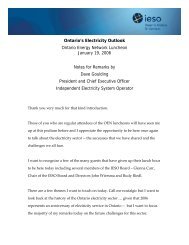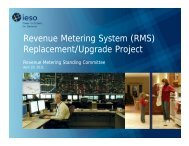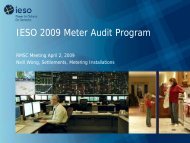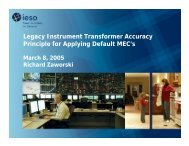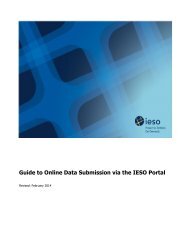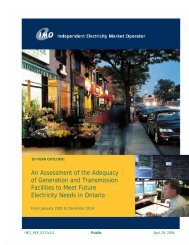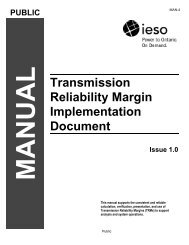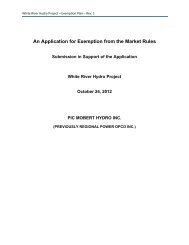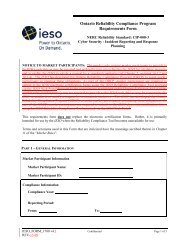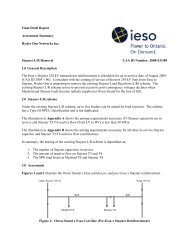Participant Technical Reference Manual - IESO
Participant Technical Reference Manual - IESO
Participant Technical Reference Manual - IESO
You also want an ePaper? Increase the reach of your titles
YUMPU automatically turns print PDFs into web optimized ePapers that Google loves.
4. Operational Metering Equipment & AGC IMO_MAN_0024<br />
279 As a guideline to the market participants, the anticipated errors in the<br />
measurement chain described above are:<br />
a. Primary conversion 0.5% of full scale<br />
b. Secondary conversion (transducers) 0.5% of full scale<br />
c. Report by the RTU, comprising analogue to digital<br />
conversion by the RTU and quantification errors<br />
1.0% of full scale<br />
280 The above accuracy standards are expected to be met by all new installations.<br />
However, for existing installations, the existing instrumentation transformers<br />
and burdens will be accepted by the <strong>IESO</strong>, for the life of the instrumentation<br />
transformers, except where their accuracy is insufficient for monitoring<br />
quantities that affect the system limits of the <strong>IESO</strong> controlled electricity<br />
network. It is up to the market participant to ascertain with the <strong>IESO</strong>, during<br />
facility registration, whether the accuracy of their instrumentation transformers<br />
would have such impact.<br />
4.1.4 Data Specifications<br />
Analogue Points<br />
Status Points<br />
281 The specific data that needs to be made available to the <strong>IESO</strong> depends not only<br />
on the electrical capacity of the market participant facility and its participation<br />
in the market, but also on other factors that influence the safe operation of the<br />
<strong>IESO</strong>-controlled grid. The detailed requirements are available in Chapter 4 and<br />
associated Appendices of the “Market Rules” and through consultation with the<br />
<strong>IESO</strong>.<br />
282 In a generic sense, the data monitored falls into two classes – analogue and<br />
status.<br />
283 These are continuously varying measurements such as watts, volts and amps.<br />
Typically the measurements are derived from a primary conversion device such<br />
as potential or current transformer and a transducer. This measurement chain<br />
scales down the actual electrical value that the RTU can report, for example, 0<br />
– 100 MW to an analogue representation of 4-20 mA or 0-1 mA. Market<br />
participants may contact the <strong>IESO</strong> for more detailed information.<br />
284 Status points are typically discreet, binary values such as the open or closed<br />
status of a switch. This information is presented to the RTU by a contact whose<br />
state is representative of the state of the device being monitored. Market<br />
participants should check the RTU vendors‟ literature for available options in<br />
status monitoring.<br />
4.1.5 Power Supply Specification<br />
285 As the data received from the RTU is an integral piece to the operation of the<br />
electricity grid, the RTU and associated communications equipment requires<br />
72 Public Issue 21.1 – March 15, 2010 - estimated




